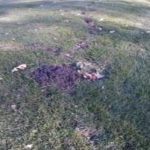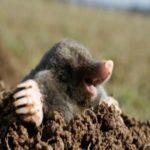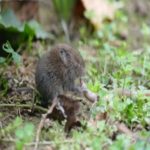Difference Between Moles And Voles

Metro Mole Control is often asked to clarify the difference between moles and voles. Their names are often used interchangeably but they are actually very different animals. Part of the confusion is that their names sound so much alike. We often chuckle because during conversations we find ourselves using the terms “Moles with an M” and “Voles with a V.”
Here are some of the basic differences between moles and voles:
Mole Traits
- Mammals of the order Eulipotyphla
- Have a v
 ery unique stocky appearance with extremely large front feet
ery unique stocky appearance with extremely large front feet - Insectivores (diet consists of grubs, insects, nightcrawlers, and worms)
- Lifespan is 3 – 6 years
- Usually, reproduce one time a year and have 2 to 6 offspring
- Rarely seen above ground and rarely leave open holes
- Live and feed almost exclusively in underground tunnels that can extend from the just below the surface to over 2 feet down
- In Minnesota, you will see mole activity from frost out to frost in (usually April to November)
Mole Damage
 Mole damage consists of turf damage including raised tunnels and occasionally mounds of dirt approximately 6-10 inches in diameter. Tunnels are identified as soft spots in the grass about as wide as your foot. This damage is caused by the underground movement of soil. It is “bottom-up” damage. Moles may kill grass and plants by disturbing their root systems but they do not eat grass or plants.
Mole damage consists of turf damage including raised tunnels and occasionally mounds of dirt approximately 6-10 inches in diameter. Tunnels are identified as soft spots in the grass about as wide as your foot. This damage is caused by the underground movement of soil. It is “bottom-up” damage. Moles may kill grass and plants by disturbing their root systems but they do not eat grass or plants.
Vole Traits
 Mammals of the order Rodentia (rodents)
Mammals of the order Rodentia (rodents)- Look like an overgrown house mouse
- Herbivores (diet consists of seeds, bulbs, plants, roots, grass, and tree bark)
- Lifespan is 3 – 6 months
- Reproduce many times a year and have 5 to 10 offspring every cycle
- Often seen scurrying around above ground and always leave open holes
- Live and feed above and below ground. May live in abandoned mole tunnels, under concrete slabs, in grass or mulch and anywhere openings may be found around the foundation of a home or other structure (check out this video).
- Active 24 hours a day / 365 days a year
Vole Damage
 Vole damage consists of turf damage identified as surface runways in your grass. These runways are about 1 to 2 inches wide. This damage is caused by clipping grass very close to the root and general back and forth movement throughout the turf. Runways are usually loaded with vole urine and feces and can lead to disease and parasites. Other damage includes the girdling of small trees and ornamentals. Garden damage to flowers and vegetables can be extensive and costly. While voles will eat seeds and roots located underground, most of their damage is “top-down.” In Minnesota, vole damage occurs year-round but is often more visible in the spring right after snowmelt.
Vole damage consists of turf damage identified as surface runways in your grass. These runways are about 1 to 2 inches wide. This damage is caused by clipping grass very close to the root and general back and forth movement throughout the turf. Runways are usually loaded with vole urine and feces and can lead to disease and parasites. Other damage includes the girdling of small trees and ornamentals. Garden damage to flowers and vegetables can be extensive and costly. While voles will eat seeds and roots located underground, most of their damage is “top-down.” In Minnesota, vole damage occurs year-round but is often more visible in the spring right after snowmelt.
While this article does not specifically address pocket gophers, you can learn how to identify their damage in comparison to moles and voles on our FAQ page located here. Much like moles, pocket gopher damage is “bottom-up.” Pocket gophers do not create surface tunnels but always create mounds that are usually much larger than that of a mole mound.
Unsure about a specific Minnesota yard pest and what you should do? Whether it’s a “Mole with an M,” a “Vole with a V,” a pocket gopher, or any other yard pest, Metro Mole Control can help with identification and problem resolution. Please give us a call or complete our Contact Us form by selecting the “GET HELP NOW” button below!
Join Us On Our Social Media Sites!

 ery unique stocky appearance with extremely large front feet
ery unique stocky appearance with extremely large front feet  Mammals of the order Rodentia (rodents)
Mammals of the order Rodentia (rodents)